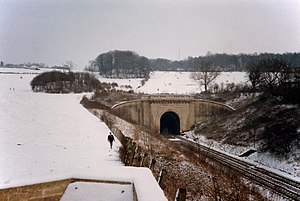Box Tunnel

Winter view of western portal
|
|
| Overview | |
|---|---|
| Line | Great Western Main Line |
| Location | Box Hill, Wiltshire, England |
| Coordinates | 51°25′17″N 2°13′34″W / 51.42128°N 2.22617°WCoordinates: 51°25′17″N 2°13′34″W / 51.42128°N 2.22617°W |
| Status | Open, operational |
| Operation | |
| Work begun | December 1838 |
| Opened | 30 June 1841 |
| Owner | Network Rail |
| Operator | Network Rail |
| Technical | |
| Length | 1.83 miles (2.95 km) |
| Operating speed | 125 miles per hour (201 km/h) |
| Grade | 1:100 |
Box Tunnel is a railway tunnel in Western England, between Bath and Chippenham, dug through Box Hill, and is a significant structure on the Great Western Main Line (GWML). It was built for the Great Western Railway (GWR) under the direction of the railway's engineer Isambard Kingdom Brunel.
The tunnel is 1.83 miles (2.95 km) in length, straight, and descends on a 1 in 100 gradient from the east. Box Tunnel is to be electrified with catenary as part of the GWML electrification scheme, scheduled for completion in 2016.
Proposed in the 1835 Great Western Railway Act, the construction of a tunnel through Box Hill was considered an impossible and dangerous engineering project due to its length and the difficult underlying strata. The rocks through which it passes are Great Oolite on top with fuller's earth, Inferior Oolite and Bridport Sand beneath, a combination with which tunnellers at the time were already familiar.
The Great Oolite limestone, known locally as Bath Stone, is easily worked and had been mined for construction purposes since Roman times, particularly during the 17th and 18th centuries when, extracted by the room and pillar method, it was used to build many of the buildings in Bath, Somerset.
To assess the strata more accurately, between 1836 and 1837 Brunel sank eight shafts at intervals through the hill along the projected alignment to establish the nature of the underlying rock.
The GWR company selected two contractors from a tendering process. George Burge of Herne Bay was the major contractor, responsible for 75% of overall tunnel length working from the west. He appointed Samuel Hansard Yockney as his engineer and manager. The locally based Lewis and Brewer were responsible for the remainder, starting from the east.
...
Wikipedia
